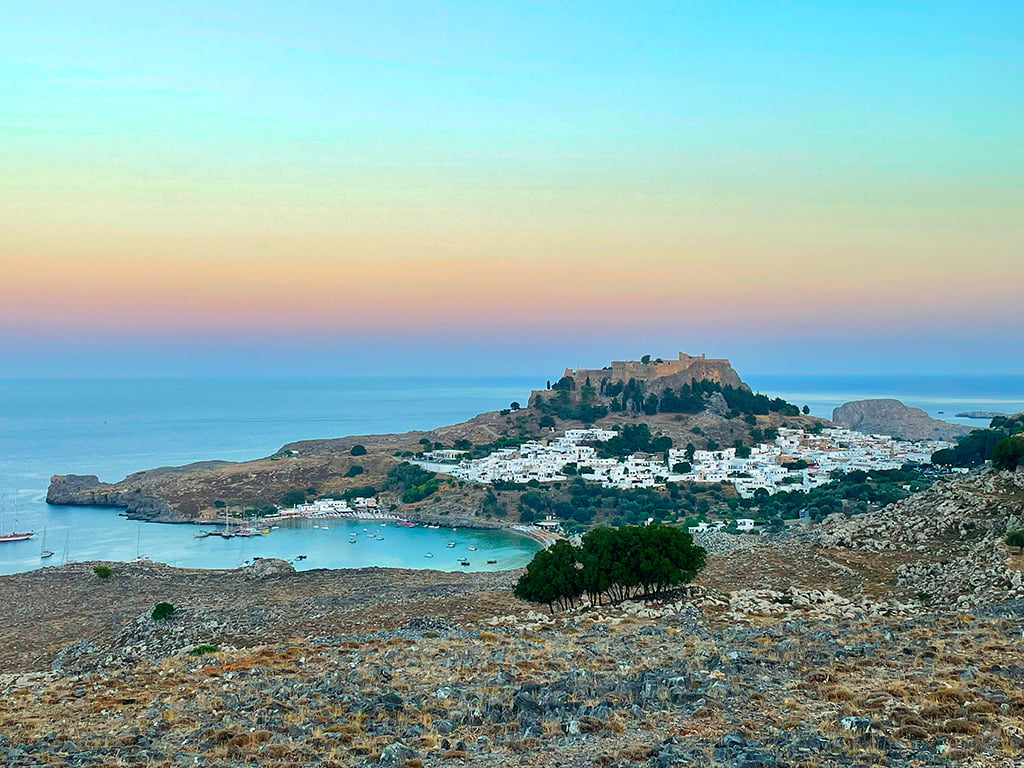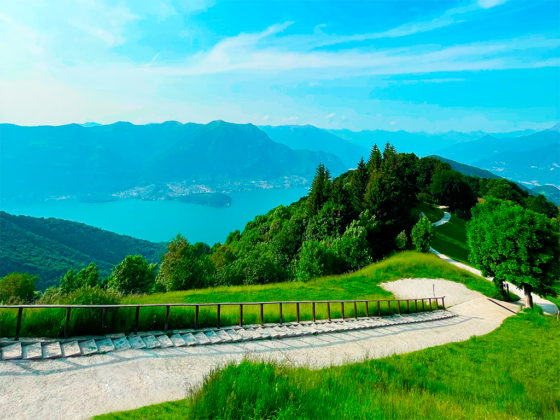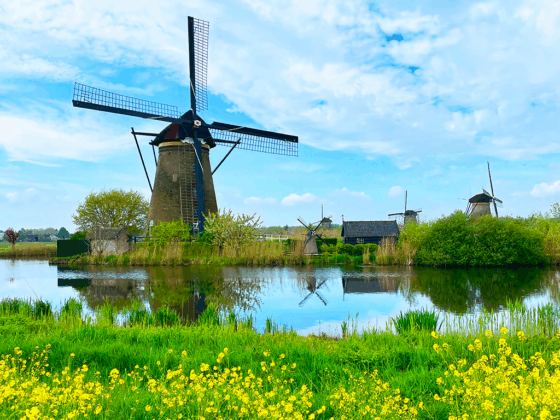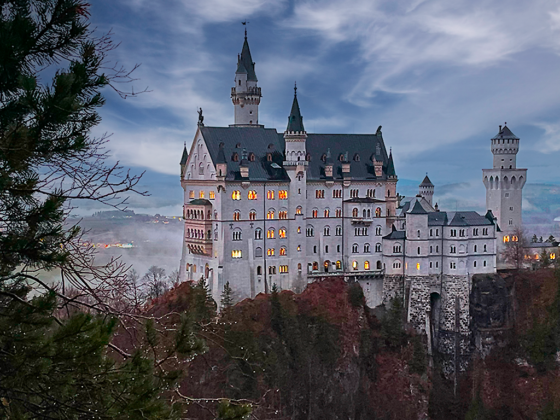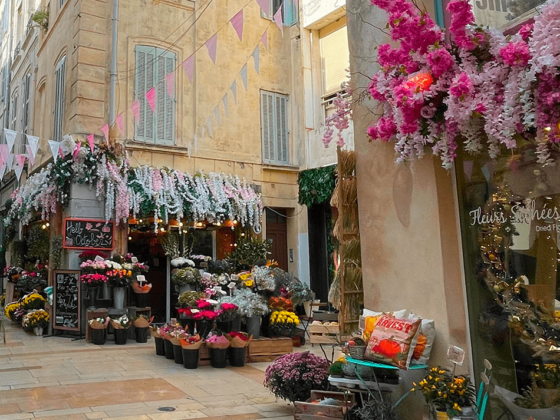When I think of a summer tour, almost by deformation of origin, the first thought is ‘sea’. And by that I don’t mean beach life (because of my complexion and hyperactivity it doesn’t suit me very well, Paolino envies those who do!) but rather the idea of sea air, the sight of the sea, its background noise.
The second thought is ‘discovery’. In our travels we like to get to know the lands we visit deeply, exploring as much as possible what a new place has to offer us, enjoying every form of discovery to the fullest, be it a beach, a site, a village or a nature trail.
If there is one land that encapsulates all this, it is Greece! So, map in hand, we chose the combo of two Dodecanese islands, perhaps less touristy than their more famous sisters (not so much, though), but full of beauty, nature and history: Rhodes and Kos.
In this first article, we tell you about Rhodes, the island of Colossus – one of the seven wonders of the classical world – is the largest island of the Dodecanese, just 17 km from the Turkish coast. Visiting Rhodes means combining crystal-clear sea, wild and unspoilt nature and ancient and fascinating history.
- Itinerary in a nutshell
- Day 1: Jacob’s canyon, Monolithos Castle and Prasonisi Beach
- Day 2: Kamiros Archaeological Site, Kopria Beach and Kritinia Castle
- Day 3: Cape Archangelos Beach, Red Sand Beach, Agathi Beach and Feraklos Castle
- Day 4: Acropolis of Lindo, Paralia Agios Pavlos and Antony Quinn Bay
- Day 5: Epta Piges, Tsambika Beach and Church of the Virgin Mary Tsambika
- Day 6: Butterfly Valley, Kallithea Spa and Kallithea Beach
- Day 7: Rhodes (Old Town, Mandraki Harbour, Mount Smith and Acropolis of Rhodes)
- Day 8: Symi
Itinerary in a nutshell
Our trip lasted 15 days, not counting the day of arrival in Rhodes (late afternoon) and departure from Kos (in the morning).
We spent 8 days in Rhodes, travelling 570 km up and down the island with a base in Lindos for 4 days and Rhodes town for the remaining 4. We were able to enjoy some of the island’s most beautiful beaches – Agios Pavlos Beach, Red Sand Beach, Kallithea Beach, Kopria Beach and Antony Quinn Bay – as well as beautiful oases and natural sites – The Forest of the Seven Springs, The Valley of the Butterflies, Kallithea Thermae and Jacob’s Canyon – with an eye to the archaeological beauties that unfailingly surprise us in Greece – Acropolis of Lindos, Kamiros Site, Kritinia Castle, Feraklos Castle, Rhodes Old Town and Monolithos Castle -. We visited Symi on a day trip, travelling by boat with an excursion to St George’s Beach; we booked an organised package but we do not recommend it and we explain why later;
TipsforTrips: To get from one island to another we used the ferry. In summer, there are up to 3 crossings a day: the first ferry leaves at 08:00 and arrives around 10:20; the last ferry is around 17:00 and reaches Kos at 20:25.The route is operated by the companies Blue Star Ferries and Dodekanisos Seaways with conventional and high-speed ferries.
On the ferries you can take the car on board but you have to book the ticket because of limited places, especially in summer. However, we preferred to rent two separate cars in order to save the cost of the ticket and we organised the stages in such a way as to save ourselves three days’ rental.
Day 1: Jacob’s canyon, Monolithos Castle and Prasonisi Beach
The first day starts with a visit to the spectacular Jacob’s Canyon, a narrow gorge surrounded by high, stratified rock walls in warm, magnetic colours. The initial part of the route is within everyone’s reach, there is some climbing on the walls or rocks, but it is easy enough even for the untrained. The landscape around it is beautiful, and it is well worth a visit.
TipsforTrips: From here you can start a circular trekking route that is almost 7 km long. The route starts by crossing the entire canyon and continues along narrow paths through lush vegetation and enchanting forest, until you reach the top of the mountain. from where you can enjoy a breathtaking view of the islands of Halki and Alimia emerging from the blue Aegean Sea. The trek through the canyon can be challenging in places, at times having to climb very exposed walls to proceed, but it is undoubtedly one of the most fascinating and characteristic routes on the island. The descent from the summit is smooth and requires no special care, allowing you to fully enjoy the extraordinary panorama.
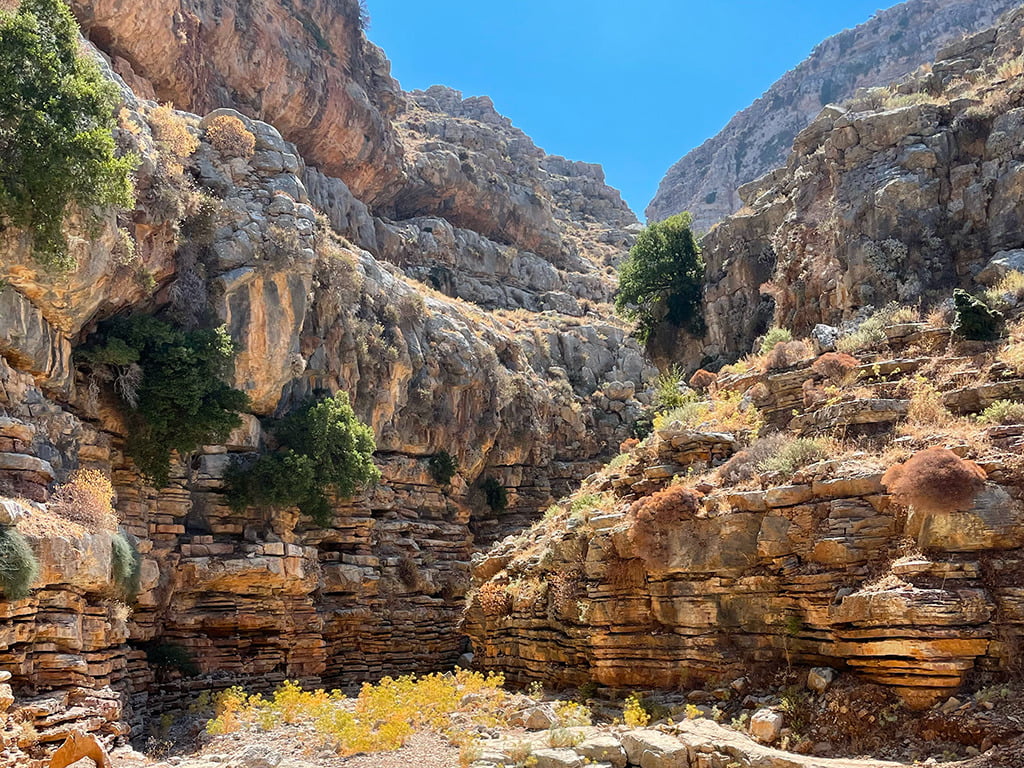
We move on to Monolithos Castle, a historic medieval fortress built around 1480 by the Knights of St John as an observation point for the south-western area of the island. It has long been an important sighting and defence site, so much so that it has always remained impregnable. Today, only ruins remain of the castle. Its peculiarity is its location, it is in fact located on top of a rocky hill overlooking the Aegean Sea, reached on foot thanks to a flight of steps cut into the rock. From the top there is a spectacular panoramic view of the west coast of Rhodes and the surrounding islands, including Halki and Alimia. Inside the castle fortress were two chapels dedicated to St George and St Pantaleo. Only the latter (Agios Panteleimon) is currently standing, visitable and equipped for worship.
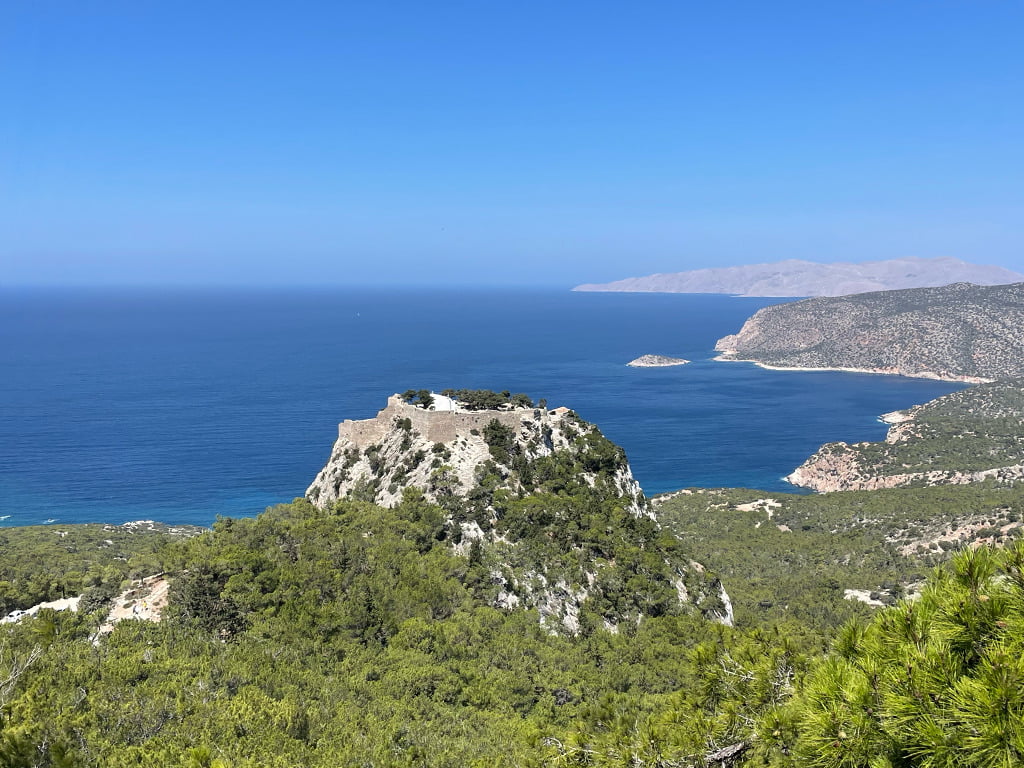
Prasonisi Beach is an extraordinary beach located at the southern end of the island. What makes it so unique is its geography. The beach is a thin, sandy tongue of land that extends into the Aegean Sea and divides the sea into two parts: on one side, the calm, shallow waters of the Adriatic, and on the other, the stronger waves of the Aegean Sea. This configuration makes Prasonisi a paradise for water sports enthusiasts, especially for windsurfing and kitesurfing.
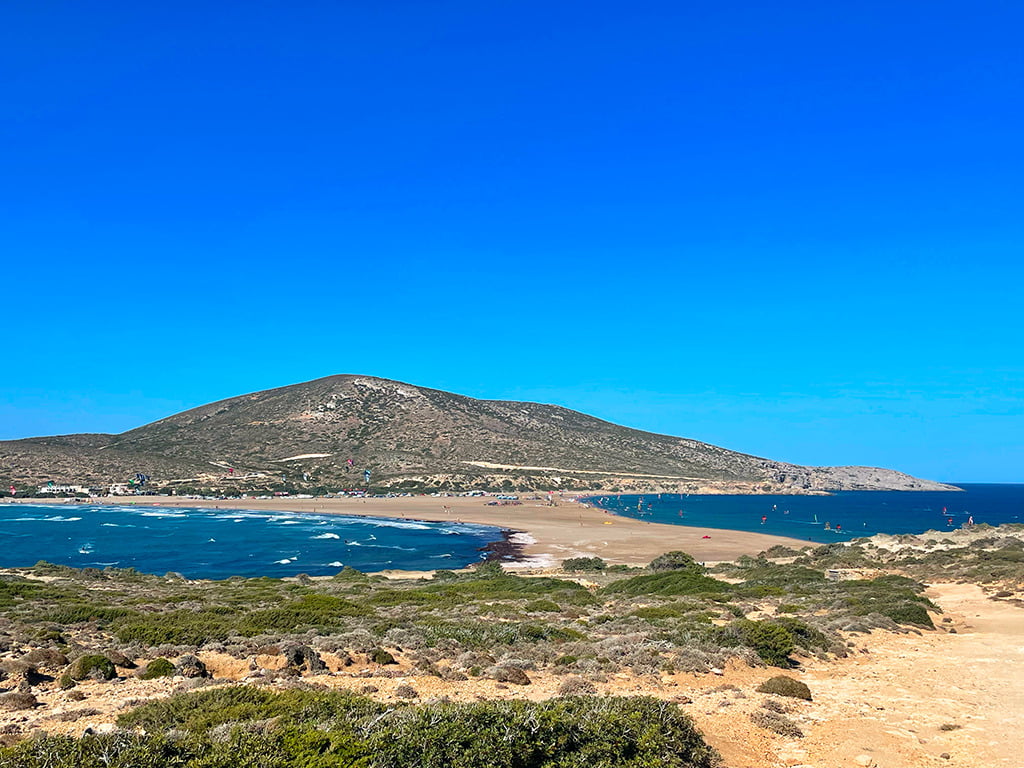
Prassonissi means Green Island in Greek because in wintertime storms, winds and tides completely cover the tongue of beach that connects the two strips of land and turns it from a peninsula into an island for all intents and purposes. We decide to take a walk on the green island and go as far as the Prassonissi Lighthouse, erected in 1890 and fourteen metres high. Having crossed the tongue of sand, we have to continue along a dirt road for about two kilometres: up to the top of the promontory and down to the outermost point where the lighthouse is located. The view is truly enchanting and surprising, especially at sunset, and will repay you for your effort.
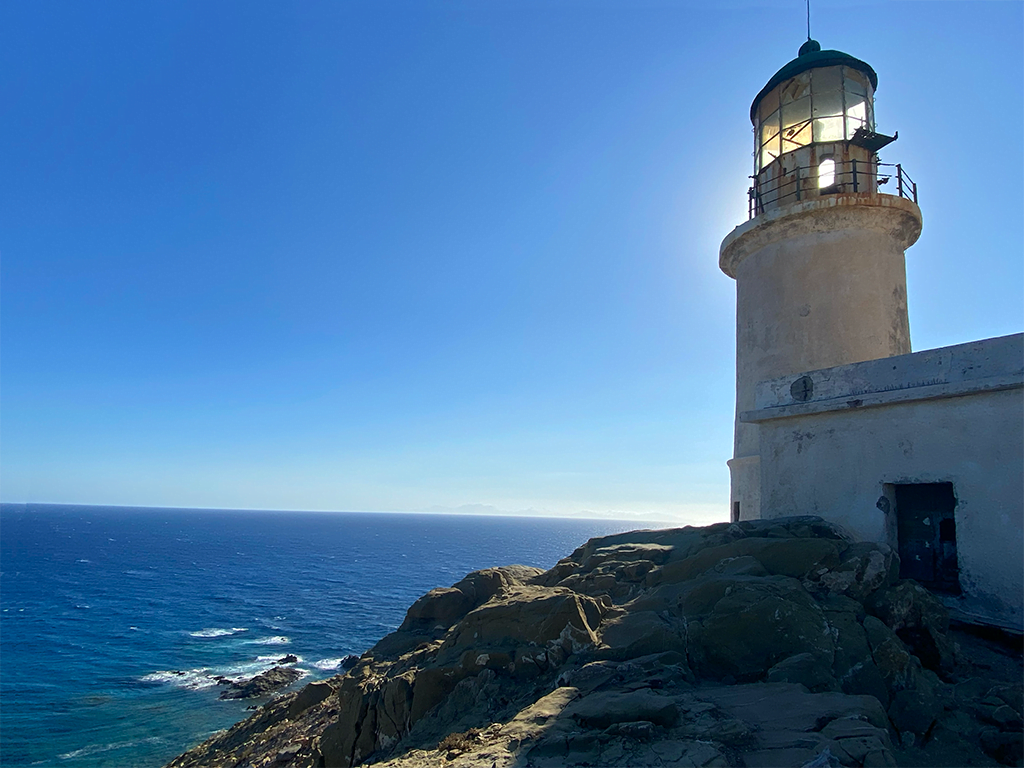
Day 2: Kamiros Archaeological Site, Kopria Beach and Kritinia Castle
Waking up early, we cross the heart of the island and move to the opposite coast until we reach the archaeological site of Kamiros.
Kamiros was an ancient Dorian city that flourished between the 7th and 3rd centuries BC. The ruins found on the site today include ancient streets, dwellings, a temple dedicated to Athena, an acropolis and a well-preserved water supply system. What makes Kamiros unique is its advanced urban planning for the time, with houses arranged on terraces and sophisticated water distribution through aqueducts. The site offers a unique opportunity to immerse oneself in the history of ancient Greece and understand how people lived and organised themselves during this period. In addition, there is a spectacular panoramic view of the coastline and the Aegean Sea.
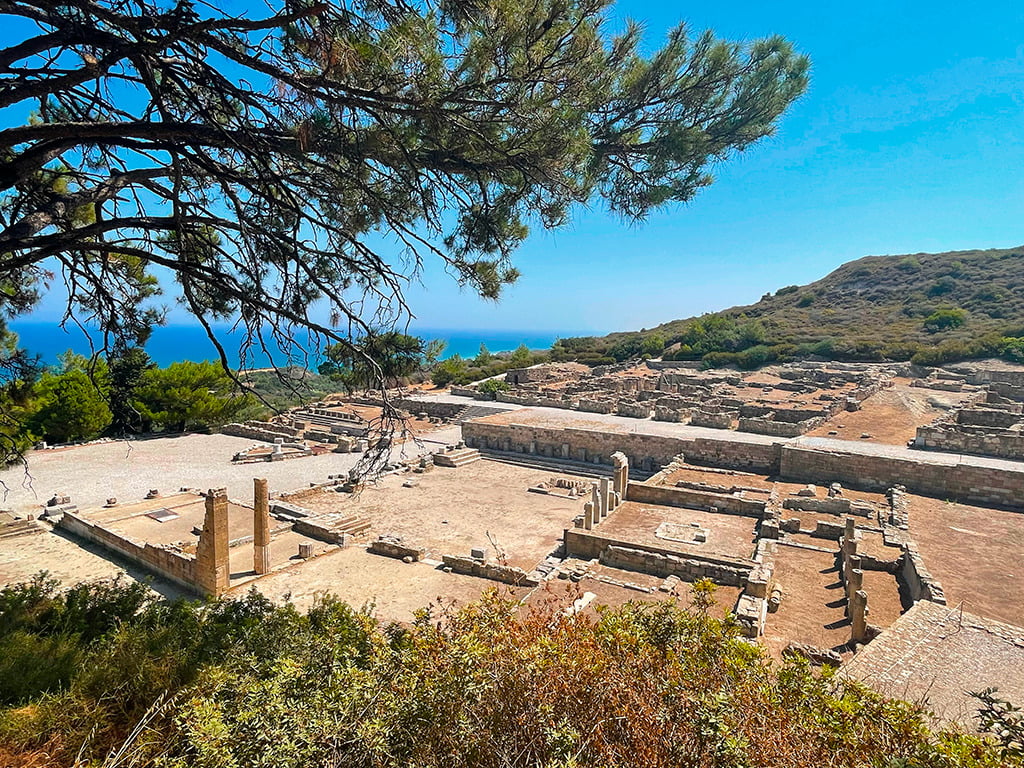
For lunch we move on to Kopria Beach. The beach is enclosed between two white cliffs – where you can also walk and take a few dips – that hug the shoreline formed by pebbles and washed by a crystal-clear blue sea, creating a surprising contrast. The atmosphere is quiet and relaxed because it is not very well known and is practically only frequented by locals. It is equipped with sunbeds and umbrellas completely free of charge and a small taverna behind where you can eat and drink simple dishes of classic Greek cuisine.
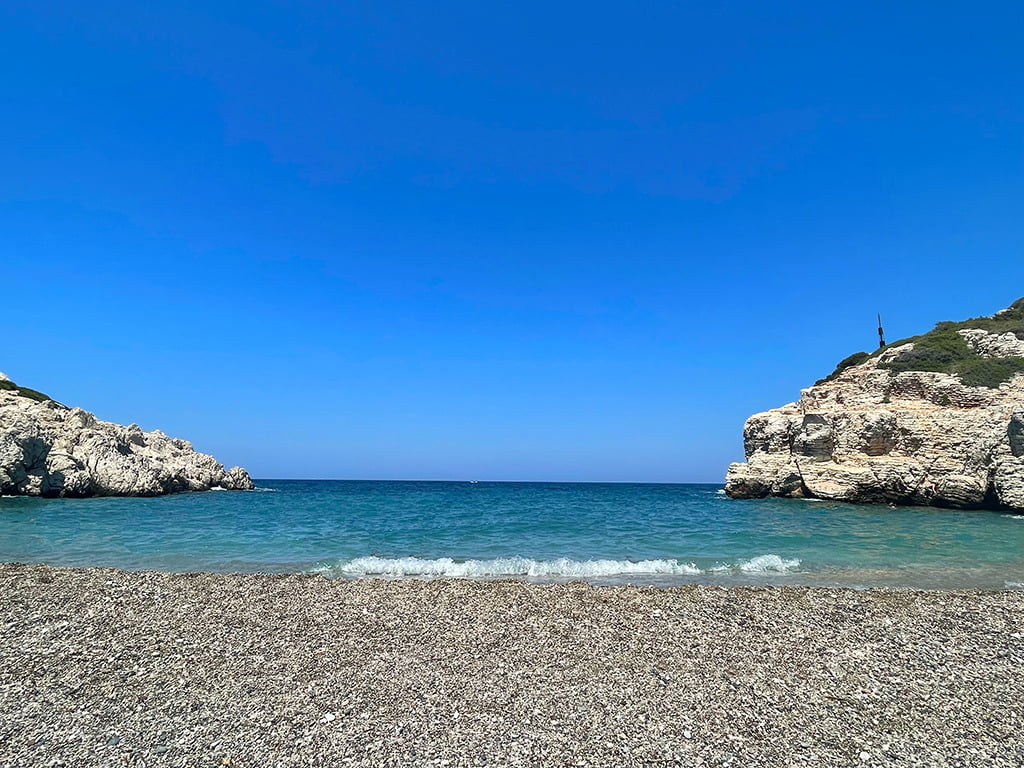
In the late afternoon we move on for the last stop of the day, about 2 kilometres from the beach is Kritinia Castle.
Kritinia Castle is a medieval castle that rises majestically on a hilltop with a panoramic view of the Aegean Sea. Its mighty walls and imposing towers testify to its long and fascinating history. The castle was built by the Knights of St. John during the medieval period, and its strategic location made it a crucial point of defence against enemy incursions. Today, only the ruins of the ancient castle remain, but there are spectacular views of the surrounding countryside and the sea all around. The castle can be reached via a stepped path that is not at all demanding. In the evening it is illuminated, making it very atmospheric and shrouded in that halo of mystery typical of castles. The castle is always open.
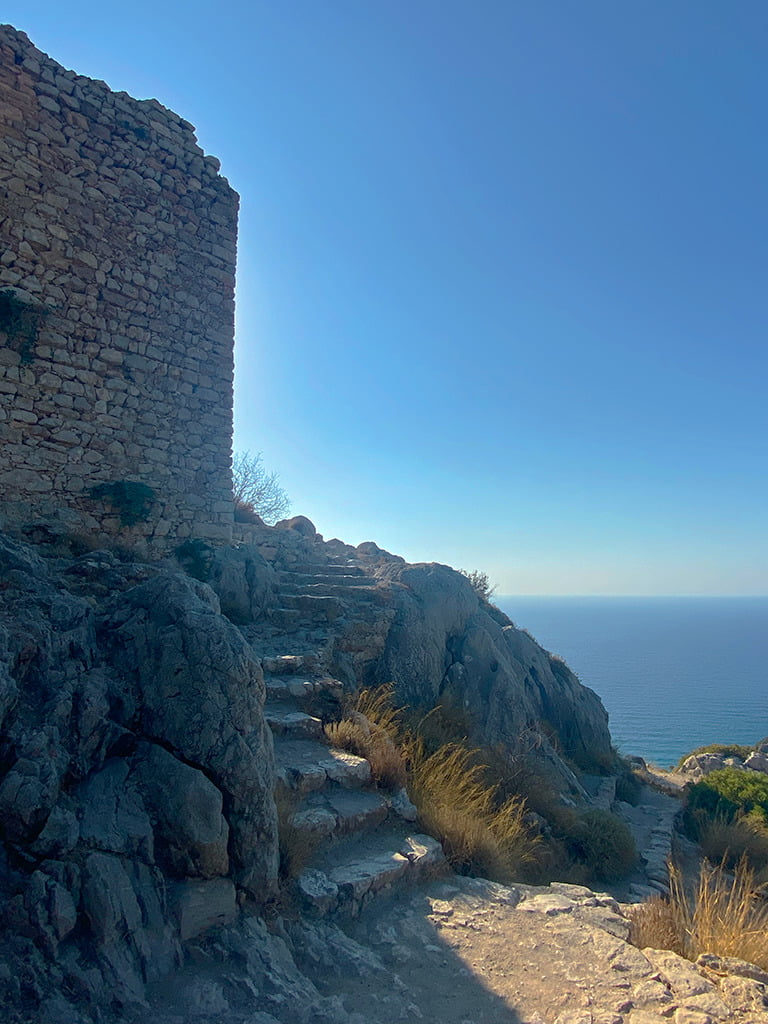
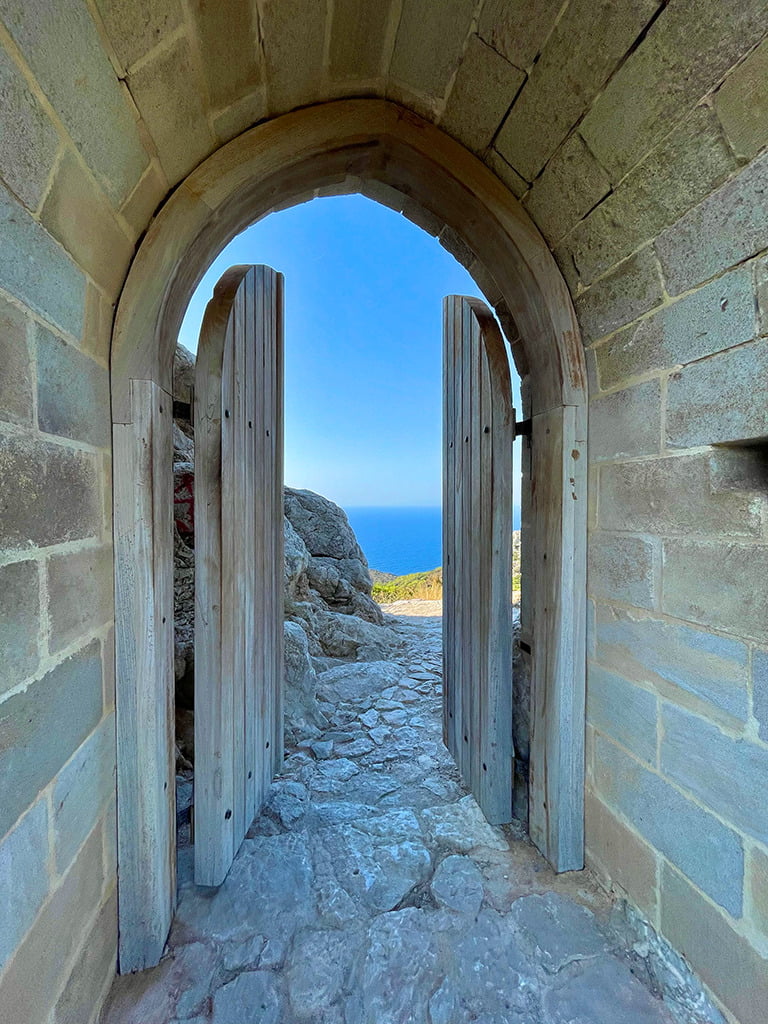
Day 3: Cape Archangelos Beach, Red Sand Beach, Agathi Beach and Feraklos Castle
Today’s day is dedicated to the beaches, starting with Cape Archangelos Beach and the Red Sand Beach, two small secret coves with incredible colours, they will leave you breathless!
The famous of the ‘two sisters’ is Red Sand Beach, which they say can only be reached by boat or kyak as it is surrounded by high cliffs. Studying the coast well, however, we discovered that there is a way to reach it by land and that is via Cape Archangelos Beach, the ‘unknown sister’. The route to get there is not easy but nothing impossible if you like a bit of adventure!
To get to Cape Archangelos Beach just follow the navigator’s directions to the dirt road leading to the beach car park, indicated on Google as ‘Parkplatz zum Strand’. The last part of the road is quite bumpy so, not very confident about the performance of our car, we stopped at the top of the hill and continued on foot. From the car park, a small path starts at the edge of the cliff, exposed but not dangerous, which ends with a flight of stone steps carved into the rock. At the end of the flight of steps you continue to the right and ‘climb’ a few large boulders to reach the beach.
Cape Archangelos Beach is surrounded by high cliffs, the sand is shades of red, the sea is crystal clear and the large trees that edge the beach offer shelter from the sun. For me it absolutely wins the prize of the most beautiful beach in Rhodes!
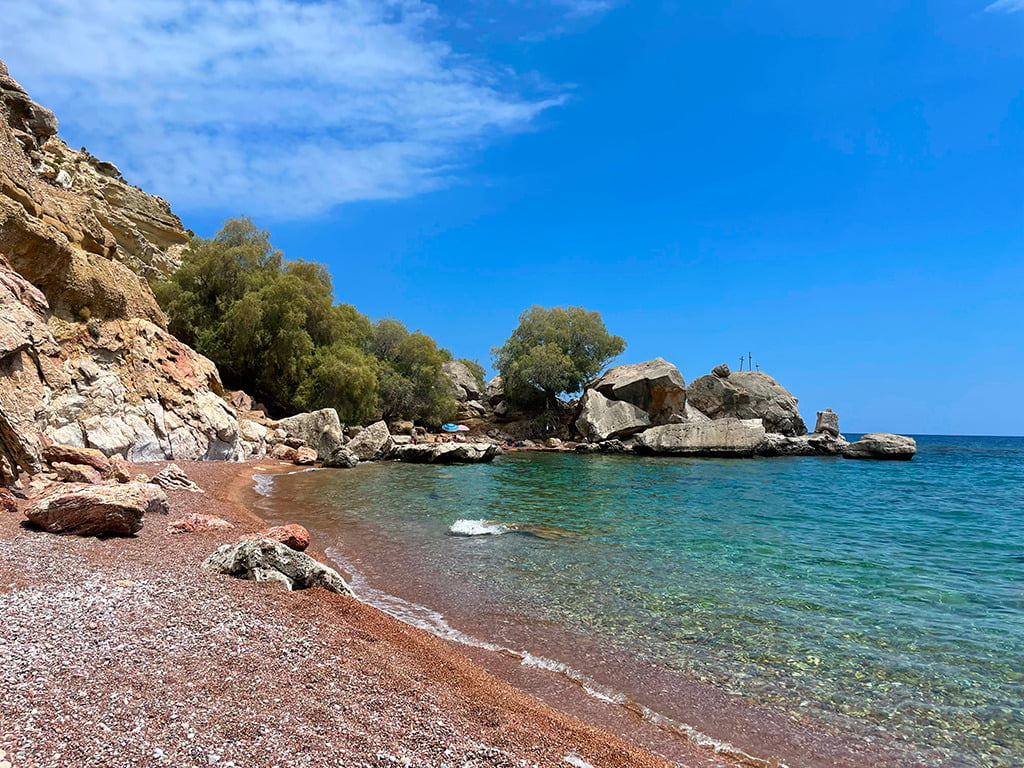
Late in the morning we move on to Red Sand Beach. There is no real path to get there, you have to cross the rocky coast that separates the two coves. The advice is to cross it pointing upwards where the coast is steeper but the path is easier, comparable to a mountain path, and then descend to the other beach. At the bottom there are only fairly high cliffs that in some cases cannot be circumvented but must be climbed.
Red Sand Beach is a tiny cove of bright red sand surrounded by high cliffs, but there is no vegetation to provide shelter. As it is more popular, it is crowded with boats and kayaking groups throughout the day. We stop just long enough to catch our breath, play with the little goats who are the undisputed masters here, and after a nice swim we head back.
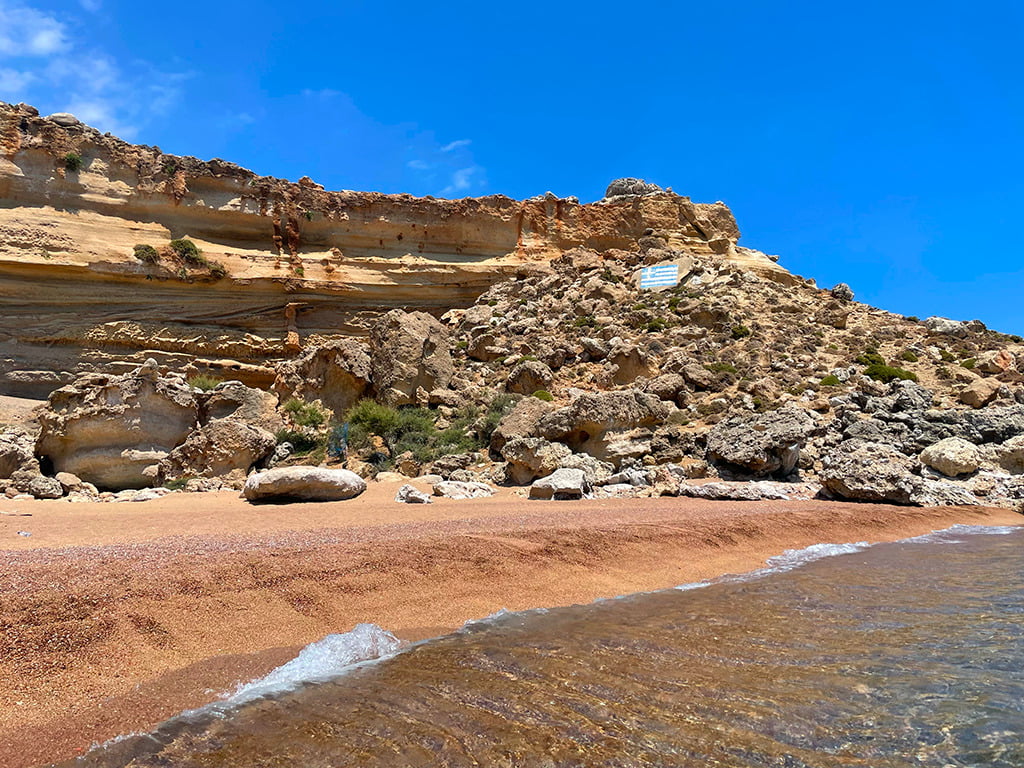
TipsforTrips: both beaches are not equipped and have no refreshment points so it is recommended to have plenty of water and to bring a packed lunch. For those who like to relax on the beach, I recommend spending all day at Cape Archangelos Beach and only taking a short excursion to Red Sand Beach. It should also be considered that, being surrounded by very high walls in the mid-afternoon, the beaches remain totally in the shade.
We then move on to Agathi Beach to end the day. Considered by many to be one of the most beautiful beaches in Rhodes – in our opinion a bit of an exaggeration – it boasts soft, golden sand and a crystal-clear sea with gently sloping waters. The beach is equipped with comfortable sunbeds and umbrellas, as well as very nice places to have a drink and eat fresh fish right on the beach. Reaching the beach is very easy, just follow the road signs. On arrival you are faced with a large free car park and immediately afterwards the beach set in a very special basin.
TipsforTrips: To get to the beach do NOT follow the google signs, in the final section, which will make you deviate from the main road to a bumpy dirt road with very narrow vegetation along the sides! The beach is well signposted with signs and directions, follow those and you will arrive by the easiest road.
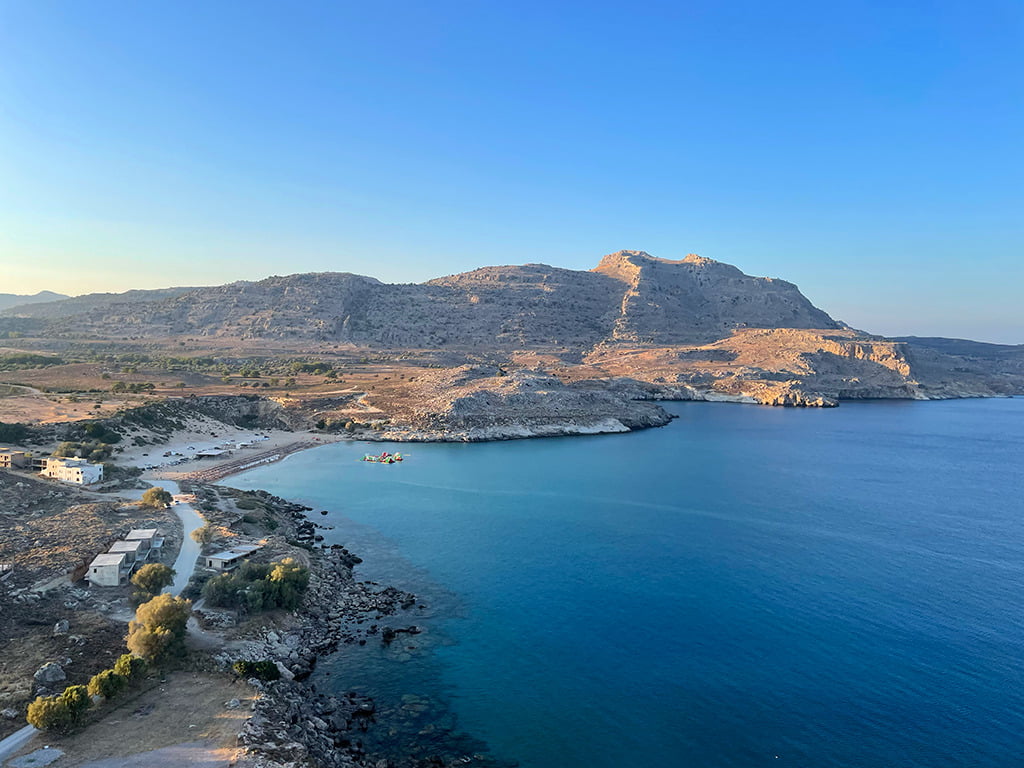
The last highlight of the day is Feraklos Castle. This imposing castle, built on the site of an ancient Acropolis, has a rich history. Initially used by pirates, it was later adapted to the needs of the Knights of St John, who reinforced it and turned it into a prison. Although only the remains of the outer walls remain and the structure is in a state of disrepair – inside, brambles and shrubs have taken over – its majesty catches the eye from afar, especially at night when the ruins are atmospherically lit. Moreover, thanks to its location, perched on a rocky hill 300 metres above sea level, it offers a spectacular view overlooking the beautiful beach of Agathi and the village of Haraki. Reaching the top of the castle is not strenuous but some care must be taken as the path, which is poorly signposted, is not immediately visible.
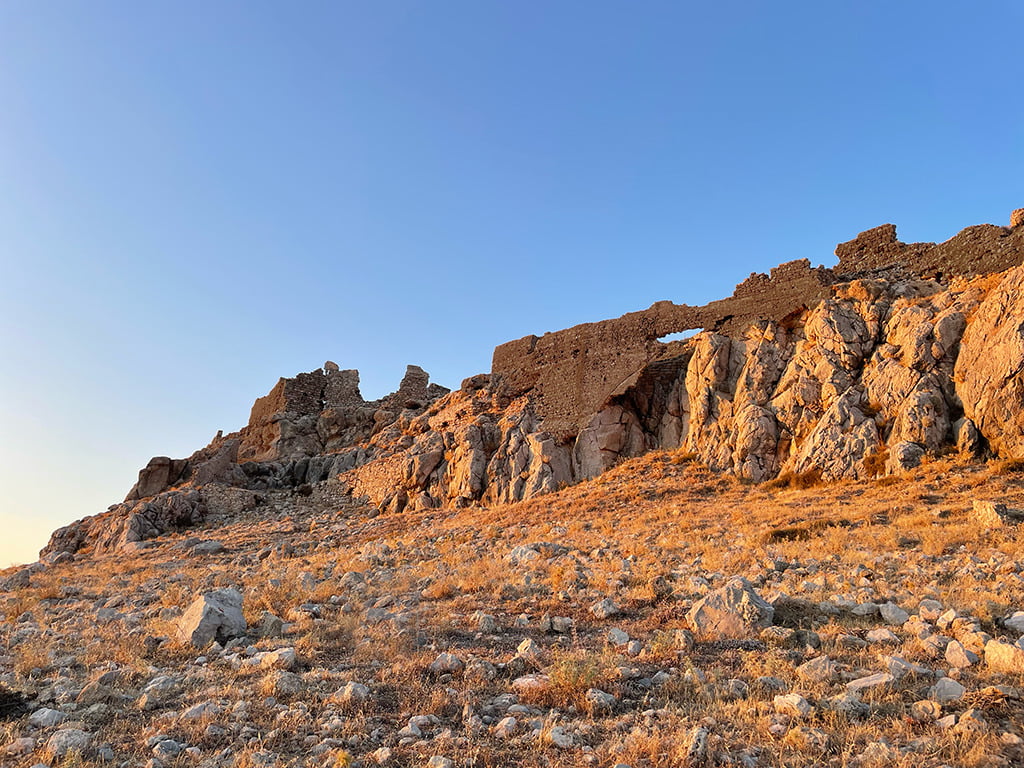
Day 4: Acropolis of Lindo, Paralia Agios Pavlos and Antony Quinn Bay
We wake up early in the morning and set out to discover Lindos, first stop the beautiful Acropolis.
TheAcropolis of Lindos is situated on a hill overlooking the sea at a height of 116 metres.
TipsforTrips: There are two possible ways to get to the top. The first starts from the alleys of the centre, is mostly made of gradin and is sheltered by trees. The road circumnavigates the cliff and offers a breathtaking view of the village and the cove – we choose it on the way up -. The second is more outward, paved but exposed to the sun, but is accompanied by a splendid view of the sea and Agios Pavlos – we take it on the way back. Comfortable shoes, water and a hat are a must for the climb! Once at the top, however, there is a well-stocked kiosk with cool drinks and snacks.
As in many places in Greece, there is the possibility of reaching the summit on a donkey, but we have good legs and prefer to spare him this effort.
What is special about the Acropolis are the numerous archaeological remains found in the area. There are not only remains from Greek times, but also monuments dating back to the Middle Ages, such as the Castle of the Knights of Rhodes, built in the 14th century and then restored during the Italian occupation in the first half of the 20th century. A church from the Byzantine era enriches the complex, bearing witness to the first centuries of Christianity, while a series of columns built in the 3rd century B.C. complete the historical picture with fragments from the Hellenistic period: these are in fact the remains of an ancient portico, or Stoà, dating back to the Greek presence on the island. Here you can buy ticket.
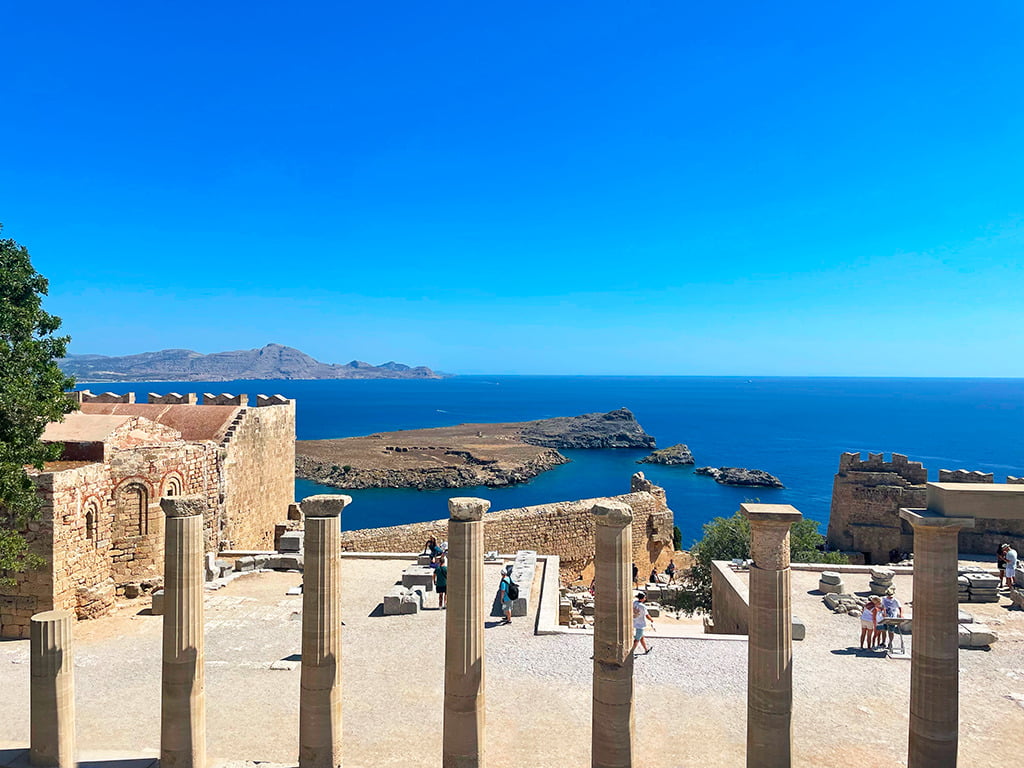
We walk back down the alleys of Lindos, a small village of narrow lanes – where only pedestrians are allowed – and low, blindingly white houses clinging to the cliff. It is surrounded by a beautiful bay to the north and a small beach to the south. Strolling through this picturesque village gives one a taste of ancient Greece. To keep this atmosphere intact, no structural changes can be made to the buildings of Lindos, many of which date back to the 15th century. The village’s distinguishing feature are the beautiful typical taverns with tables set up on the panoramic terraces that light up in the evening, giving the village a magical atmosphere. Not to be missed is the Church of the Panagia, in the centre of the village, which preserves beautiful 17th century frescoes and icons.
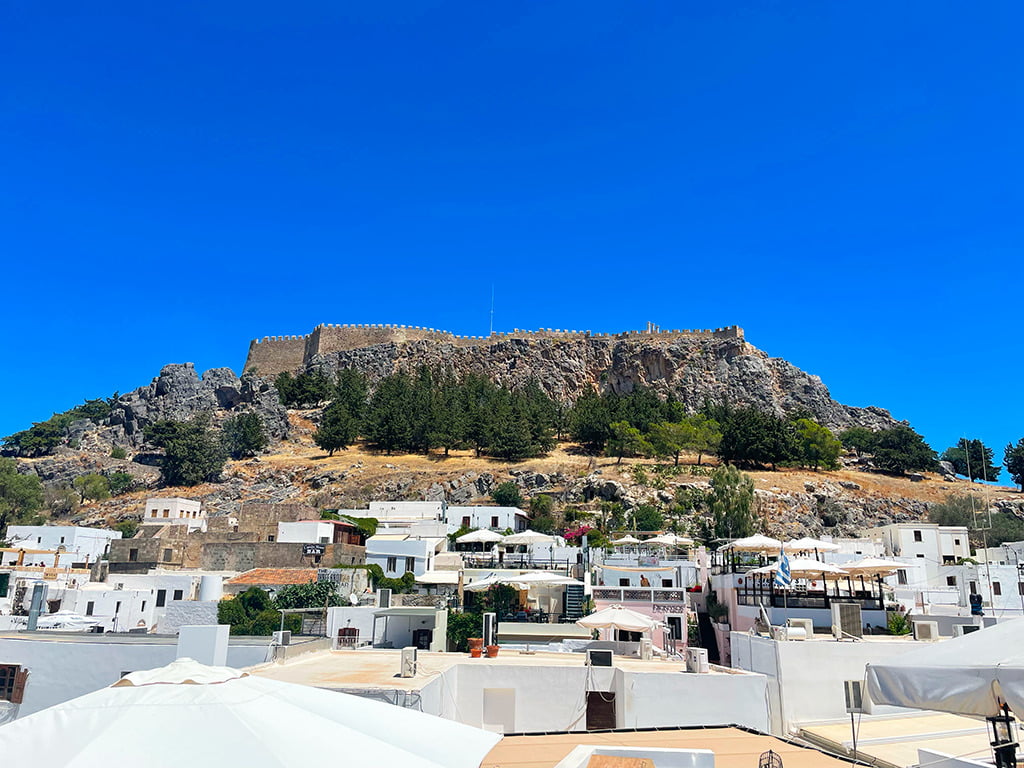
After lunch, we stop to admire the bay of Agios Pavlos. The bay consists of two small beaches surrounded by high rocks forming a pool, both made of soft golden sand mixed with gravel, clear, transparent turquoise and emerald waters. On the beach is a beautiful chapel dedicated to Agios Pavlos (St Paul). Given its fame, the beach is overcrowded and full of boats, as we expected, we take a few photos and move on to the next stop.
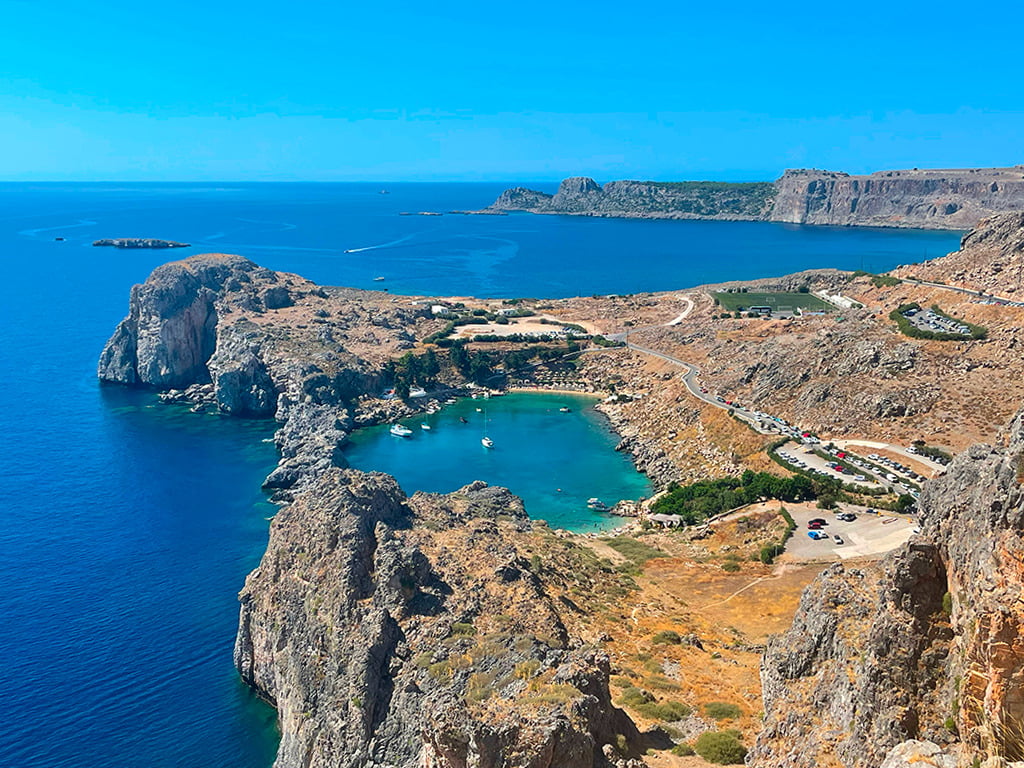
We leave Lindos and its marvellous beauty, for the next few days we will be based in Rhodes town.
On the way we stop at the world-famous Antony Quinn Bay. The bay, originally called Vagies Bay, owes its current name to the actor Anthony Quinn, who was so enchanted by its beauty that he decided to buy it and give it his name. When he returned it to the island in 1990, the same name was kept in his honour. The bay boasts one of the most beautiful landscapes on the island: its sandy and rocky seabed, its crystal-clear sea and the pine trees that frame it provide the picturesque scenery! The beach is very small so the advice is to arrive very early in the morning or, as we preferred, very late in the afternoon. Behind it is an excellent restaurant with a spectacular view of the cove which takes on a magical glow in the moonlight.
Day 5: Epta Piges, Tsambika Beach and Church of the Virgin Mary Tsambika
Today we take an excursion into the hinterland of Rhodes. Epta Piges is an authentic oasis with well-kept paths, wooden bridges and footbridges where peacocks and various wild birds live freely. The Seven Sources, from which this locality takes its name, are located a short distance from each other but are very difficult to find in summer. They merge into a single river that flows through an incredibly narrow tunnel, eventually flowing into a lake created by a dam in 1931 where the water becomes a beautiful waterfall. The most special attraction is this underground tunnel, 180 metres long, leading from the river to the lake. The water inside the tunnel is ankle-deep and once inside, we proceed in single file. N.B. This route is not suitable for those suffering from claustrophobia, as it is narrow and dark. One can, however, reach the pond by following a path through the forest, enjoying a beautiful nature walk. In the innermost part of Epta Piges, there is a small tavern offering Greek and local specialities.
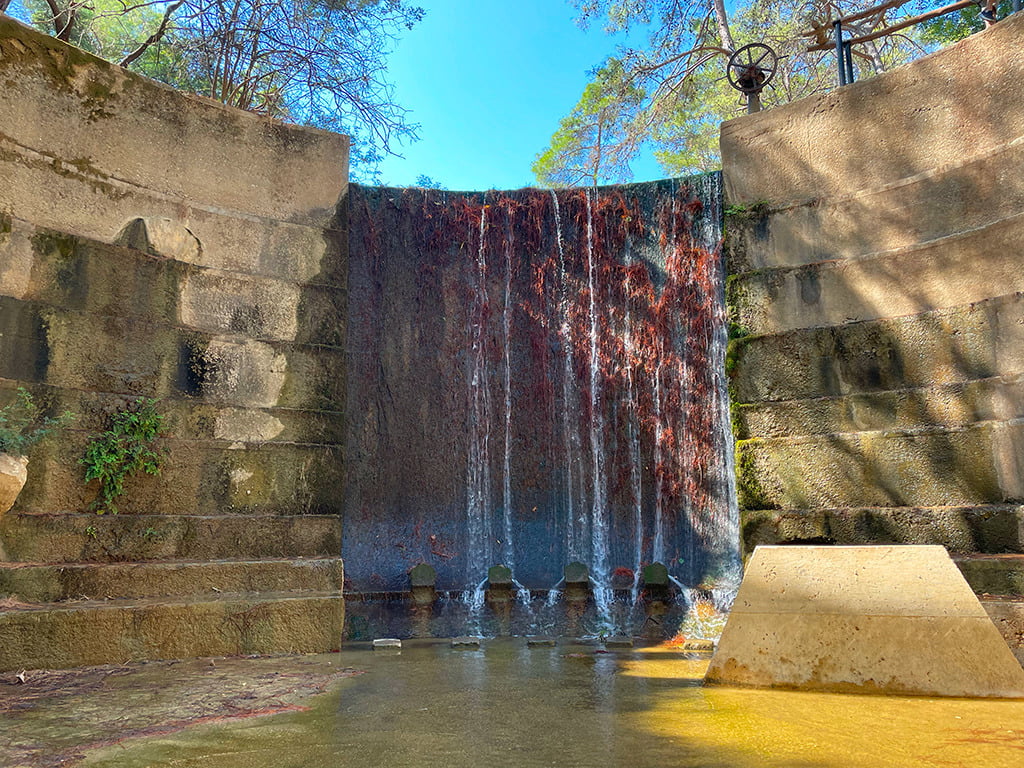
After lunch, we move on to Tsambika Beach, famous for its golden sand and the crystal-clear waters of the Aegean Sea. Along the beach, there are a number of bathing establishments and traditional tavernas, but the interesting part is that you can try out lots of water sports here. We have wanted – and by wanted I mean wanted – to go parasailing for a long time, so we decide to give it a try.
We are ready, we harness up and the boat accelerates. The parachute gradually lifts and takes us off the boat, the feeling of flying is indescribable. We find ourselves suspended in the air, lifted by the wind. From the top we enjoy the most beautiful panoramic view of the coast, the sea below us and the sea breeze make the experience magical. I don’t stop smiling for a moment, paralysis takes hold of me!
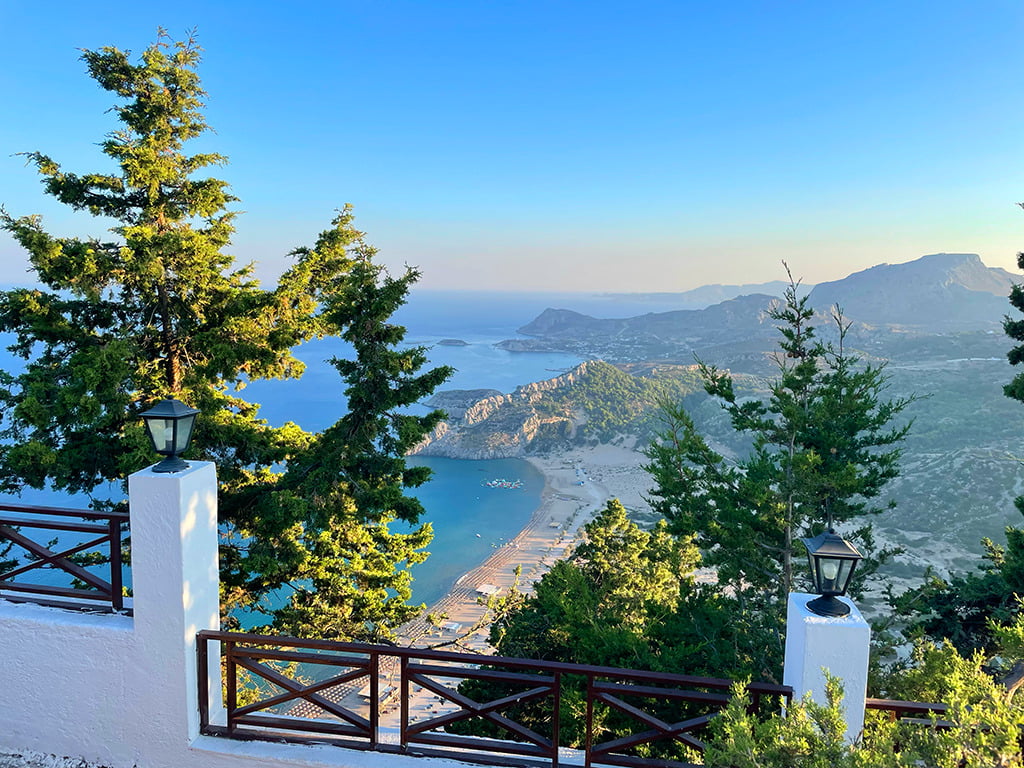
At the end of the day, when the air is cooler, we move to the hill behind the beach where the Church of the Virgin Mary Tsambika stands majestically, an important place of pilgrimage and spirituality on the island of Rhodes. To reach the church, we walk up a steep climb of about 300 steps. Once at the top, one can admire the traditional architecture of the church, alongside religious icons and candles lit by pilgrims. The quiet and serenity of the surroundings make it an ideal place for contemplation and prayer. In addition, from the top of the hill there is a spectacular panoramic view of the Tsambika Beach coastline and beyond.
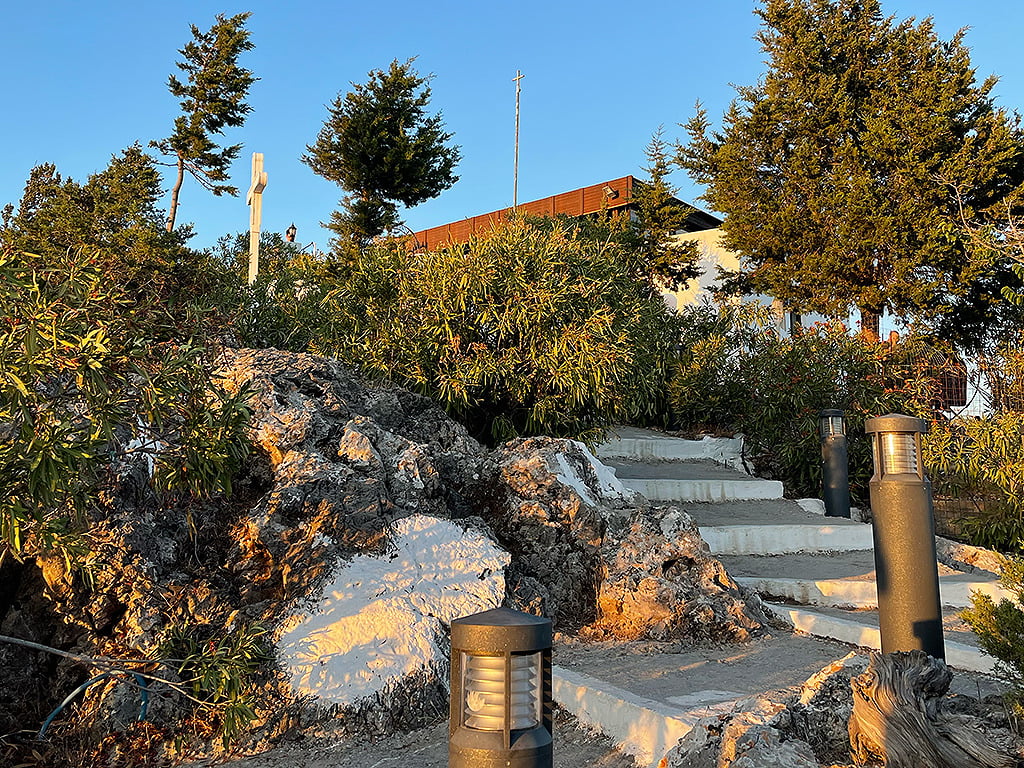
Legend has it that “in the 16th century, a shepherd and his wife, who were unable to have children, saw a shimmering above the promontory one evening and the phenomenon repeated itself for several days until they decided, together with other villagers, to go and see what was shining during the night. Climbing the difficult rocky path they discovered that the light was the reflection of a candle in front of a silver Icon of Our Lady. They decided to take it to the village and soon the discovery reached as far as the island of Cyprus where some religious proclaimed that the icon belonged to them and had been stolen somehow. Promptly the people of Rhodes returned thesacred icon, but after some time it was found again on the promontory. It was returned to the island of Cyprus three times, but each time it miraculously returned to Rhodes , and so it was finally decided that this was the place where it should remain, and the Church of the Shining Madonna (Tsambika) was built. After some time, the shepherd’s wife gave birth to a child and the miracle was repeated over time for all those women who, unable to have children, climbed barefoot to the Church to ask the Virgin Mary for grace. As a sign of gratitude for the miracle, all newborns were given the name Tsambika if they were girls and Tsambikos if they were boys‘.
Day 6: Butterfly Valley, Kallithea Spa and Kallithea Beach
Another morning, another excursion to the heart of the island. We visit the Valley of the Butterflies, a magical and enchanted place where the green of nature mingles with the red and orange of the butterflies. This valley is an oasis of serenity, where rushing streams, small wooden bridges and shady paths frame a spectacle of rare beauty. But what really makes this place special is the presence of thousands of butterflies. In the summer months, the Panaxia Quadripunctuaria (Speckled Harlequin) butterflies arrive in their millions to breed. This is a migratory species, which can only be seen here from June to August. Outside this period, only a few specimens remain.
TipsforTrips: The butterfly valley is divided into two “blocks”, in fact it has two entrances, both of which can be visited with the same ticket. Although it is advisable to park in the first car park you come across and walk up both paths, our advice is not to miss the second part, which is higher and cooler and richer in butterflies. If you arrive early enough, you can visit almost on your own (groups start from the lower part).
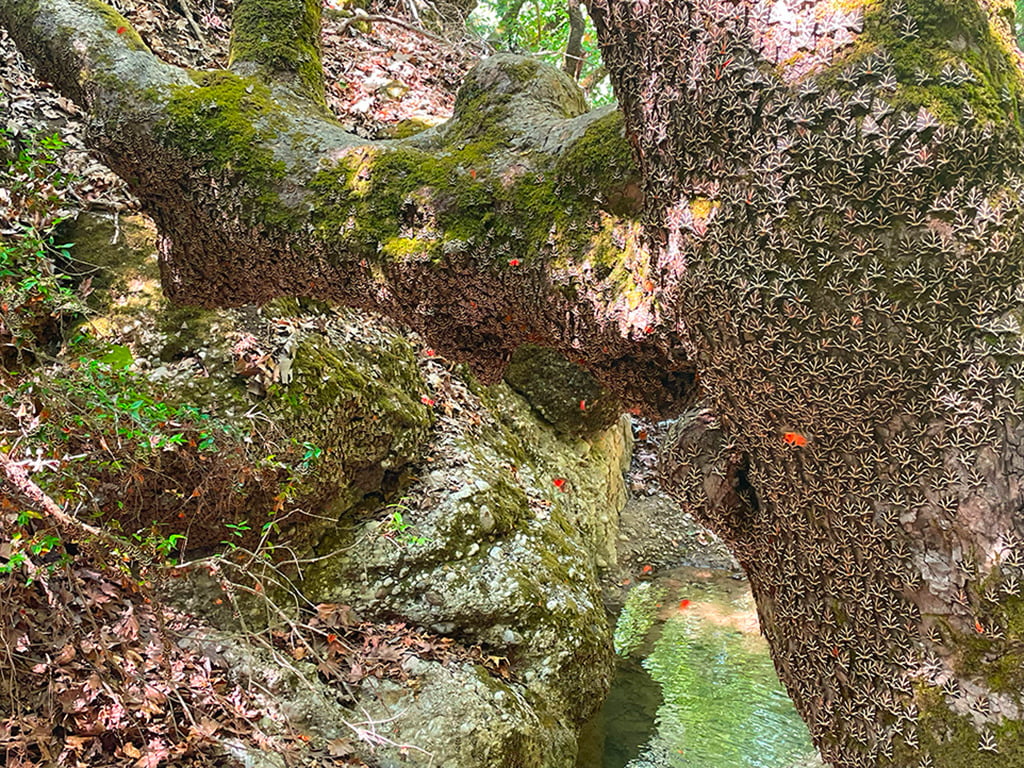
Moving to the coast, the Terme Kallithea is our next stop, a combination of history, natural beauty and wellness. Built in the 1920s during the Italian occupation, they were originally conceived as a spa, and their design is a fascinating mix of classical elements and Art Nouveau ornamentation. Although the main building has been carefully restored, its original style has been preserved, making this destination even more fascinating for architecture lovers. The Spa is set in a natural environment of outstanding beauty.
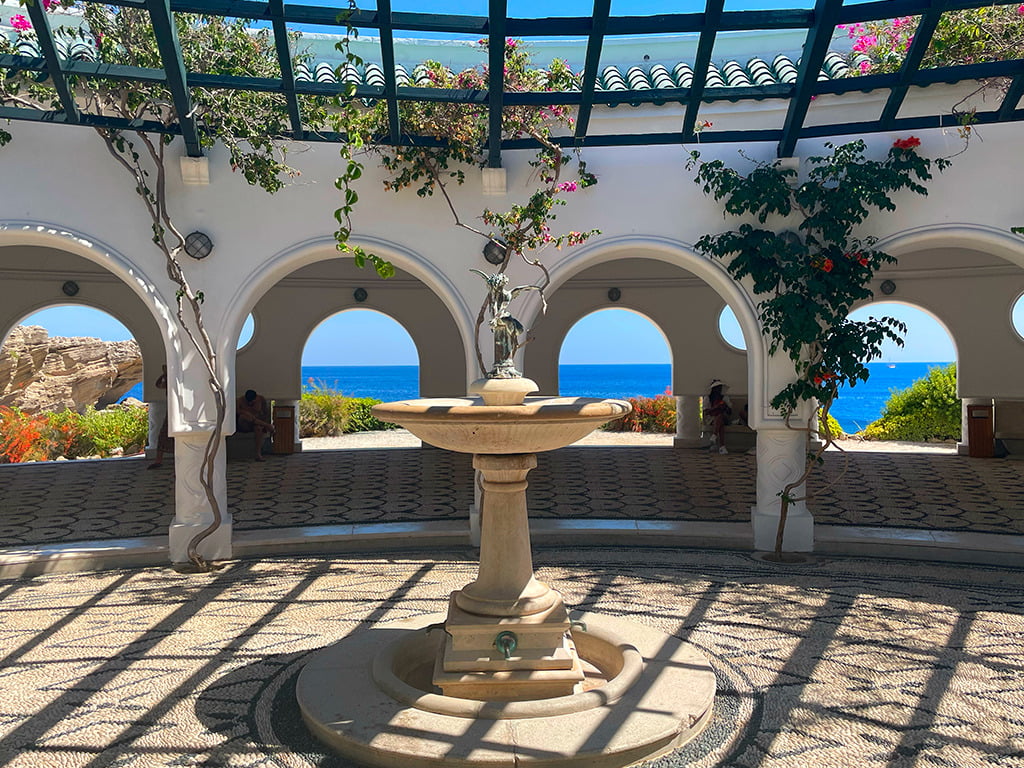
The complex overlooks a stretch of rocky coastline arranged in panoramic terraces and one can stroll among the olive and palm trees in the surrounding gardens where small waterfalls are hidden from the rocks. In the centre of the cove is Kallithea Beach, a strip of golden sand and pebbles lapped by the incredibly clear and azure waters of the Aegean Sea. The shallow, crystal-clear waters are teeming with marine life.

On the way back we go to drop off the car, over the next two days we have concentrated on the stages for which we don’t need the car so that we can save ourselves two days’ rental!
Day 7: Rhodes (Old Town, Mandraki Harbour, Mount Smith and Acropolis of Rhodes)
Although we were able to wander around the city during the evenings, we wanted to dedicate a whole day to visiting Rhodes.
We begin the day with a visit to the city walls of Rhodes. Built around the middle of the 14th century by the Knights of St John, with a length of 4 km and a height of up to 10 metres, they have been a UNESCO World Heritage Site since 1988. They are characterised by ramparts (in particular the polygonal-shaped St George’s rampart and the circular Carretto rampart), watchtowers and provide access to the old town through three gates: Porta Sant’Attanasio, Porta d’Ambroise and Porta Marina (on the sea side). Between the walls is also the moat that once served to defend the city from enemies and is now completely pedestrianised.
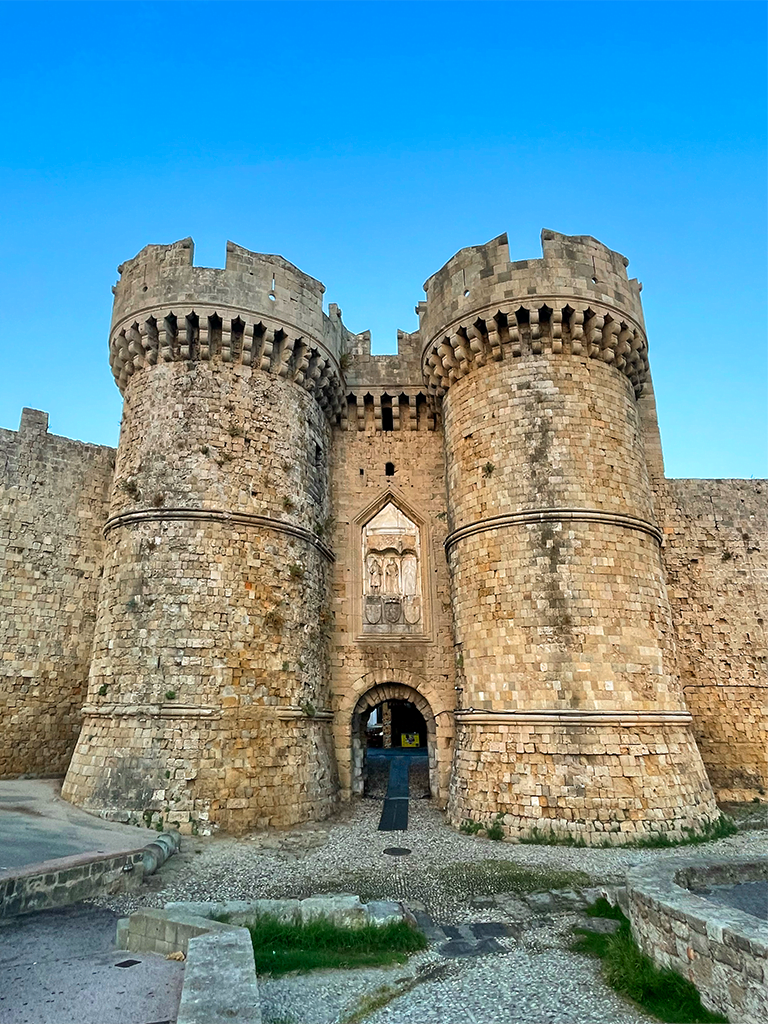
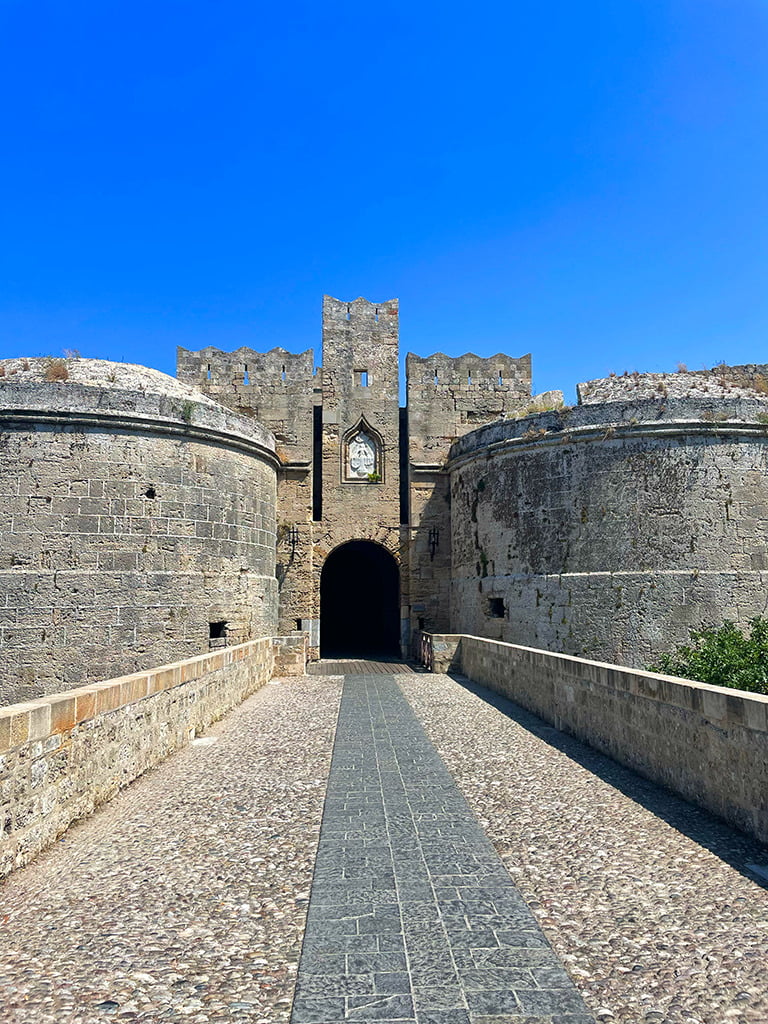
We go through the Porta Sant’Attanasio and re-enter the old town, which is totally pedestrianised and characterised by several historical monuments, taverns, restaurants and shops. We come across the Church of the Virgin of the Borgo. We get lost in the alleys and courtyards of the centre, play with the local cats and explore the ancient beauty of this town. We cross Jewish Martyrs ‘ Square to Hippocrates‘ Square, two of Rhodes’ main squares, wide and paved surrounded by historic buildings and taverns. They often host cultural events, local markets and street performers’ shows, making them a central point of activity in Rhodes’ old town.
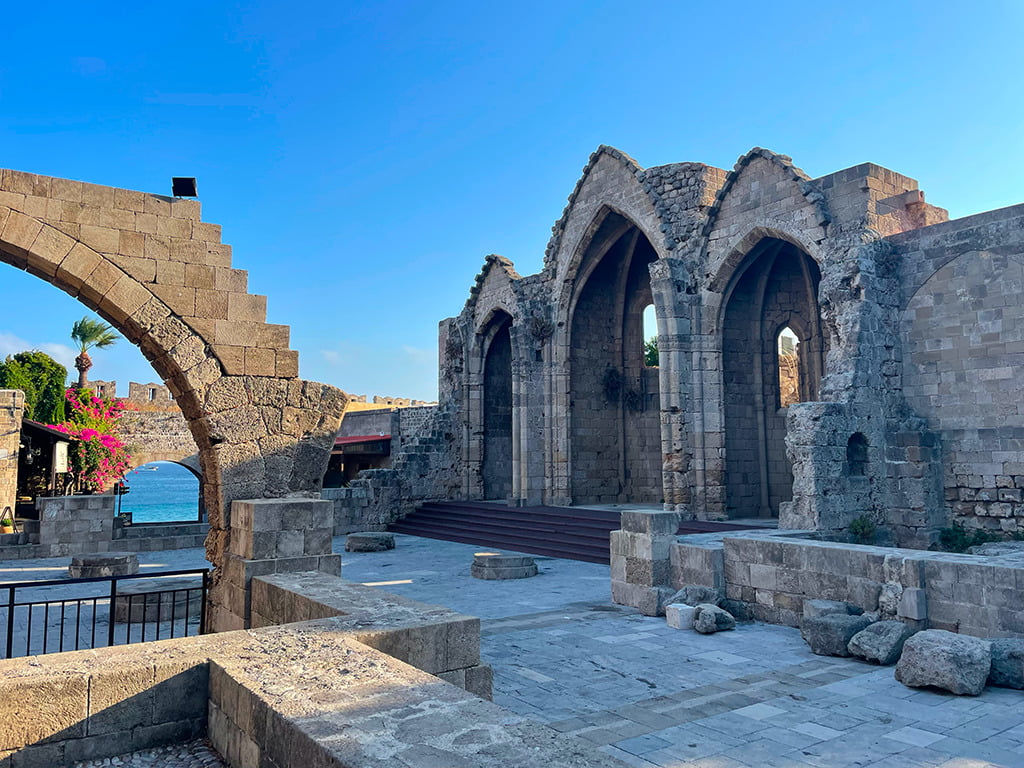
We walk up Sokratous pedestrian artery through the heart of the old town, famous for its small shops selling local products, souvenirs, handmade jewellery, traditional textiles and objets d’art. We arrive at the classical Ottoman-style Suleiman Mosque with a large inner courtyard and an elegant minaret. The building features a main dome and traditional Islamic decorations.
Next to the mosque we visit the medieval clock tower, dating back to the 14th century, a remarkable example of medieval architecture with Gothic influences. The tower houses a large mechanical clock, which was installed in the 19th century. We find it open and are also able to visit it inside. The tower is 53 steps high and there is a good view of the city from the top. Together with the entrance ticket, a cool drink is offered on the inner terrace, we take advantage of this to take a mid-morning break.
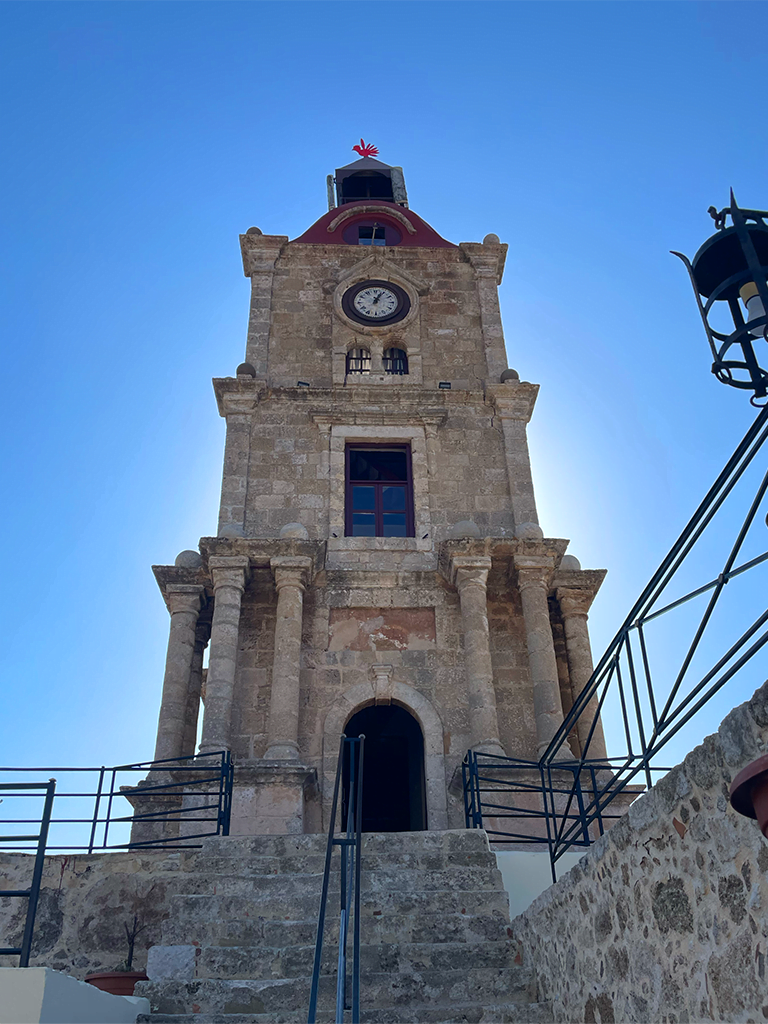

We move on to the Palace of the Grand Master, an outstanding example of medieval architecture. Its construction dates back to the 14th century and features Gothic, Gothic-Renaissance and Ottoman elements. The building is imposing, with a massive façade, defensive walls and angular towers. The palace has a rich history and was used as the seat of the Grand Master of the Order of the Knights of Rhodes, one of the most important military and religious organisations of the Middle Ages. After the Ottoman occupation, the palace was turned into a prison and later suffered damage during an explosion in the 19th century. It was restored in the 1930s and today houses a museum displaying a collection of medieval and Renaissance objects.
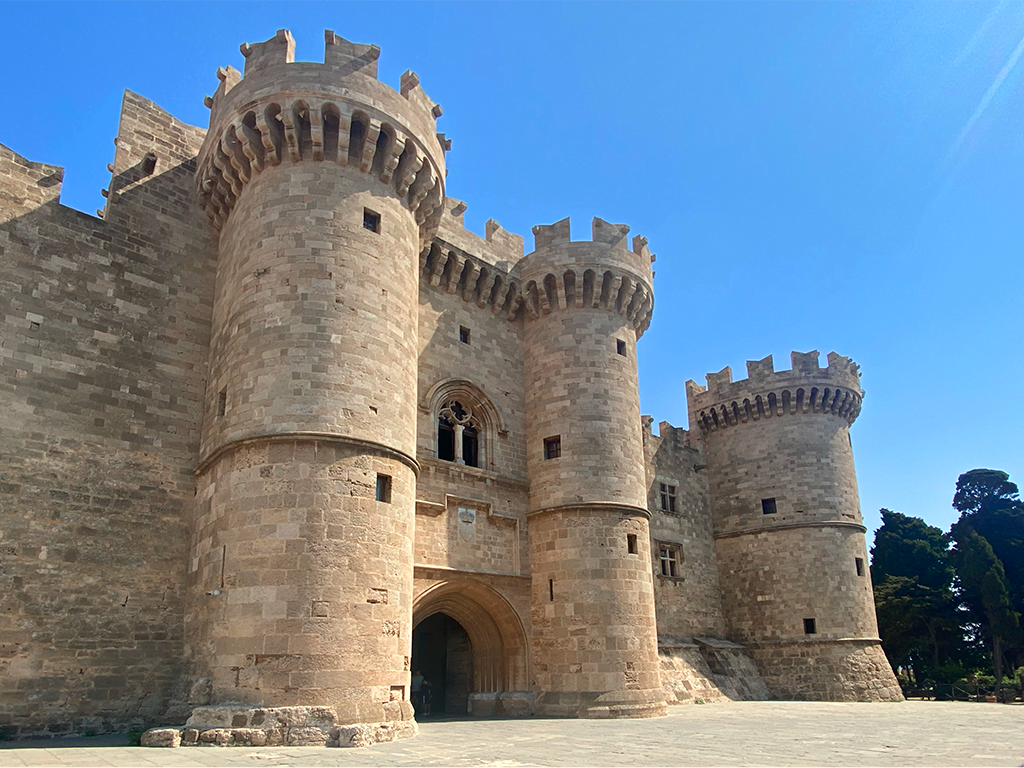
We walk along the Street of the Knights, one of the most iconic streets of Rhodes, named after the Order of the Knights of St John, who ruled the island for centuries. During the medieval period, the street was the heart of the knights’ settlement. The street is lined with well-preserved historical buildings, many of which were the residences of the different ‘tongues’ of the Knights’ Order. These buildings feature Gothic, Renaissance and Baroque architecture, each with its own distinctive style. The street is characteristically paved, retaining its medieval appearance.
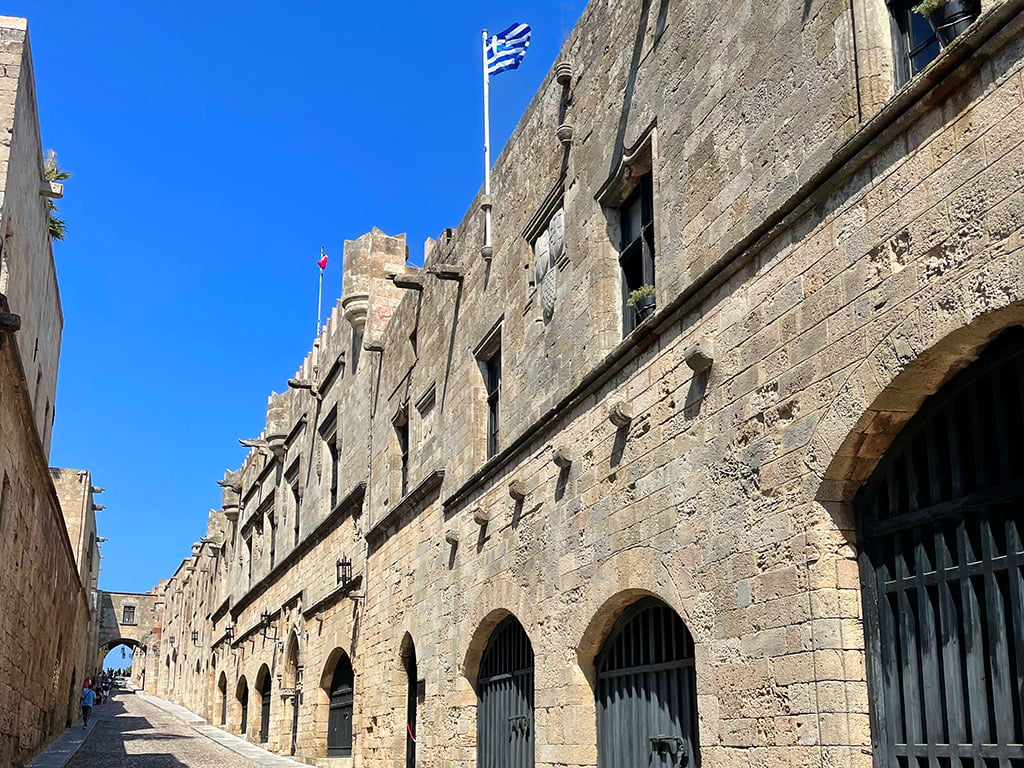
After a stop for lunch, we cross the walls again through the Freedom Gate and find ourselves at the Port of Mandraki. The harbour once housed the world-famous Colossus of Rhodes, one of the Seven Wonders of the Ancient World. Today it has two columns at the entrance above which stand two bronze statues of Elafos and Elafina, two deer that, according to legend, freed the island of Rhodes from an invasion of snakes. Along the arm opposite the pier stand the Fort of St Nicholas and the three ancient Windmills.
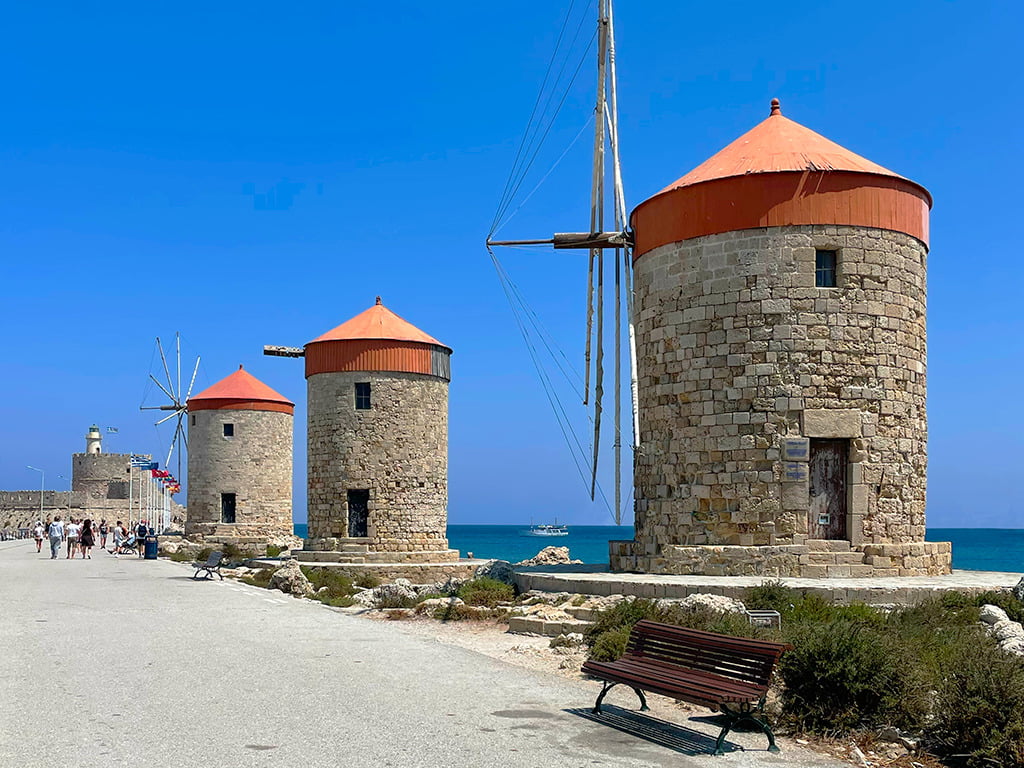
In mid-afternoon we head to Mount Smith, at a height of 112 metres above the sea, where theAcropolis of Rhodes is located. Wander around the remains of the Temple of Apollo from the 3rd century BC, where only the 3 columns, the symbol of Rhodes, remain today. In the northernmost part, on the other hand, are the ruins of the Temple of Zeus and Athena Polias, the Gymnasium – the ancient 201-metre long stadium – and the great Greek theatre that held 800 people. The Acropolis is always open and entry is free, but for us it was a bit of a disappointment – you often find misleading pictures of the acropolis on brochures that actually represent the Acropolis of Lindos -. It is a bit of a skip track.
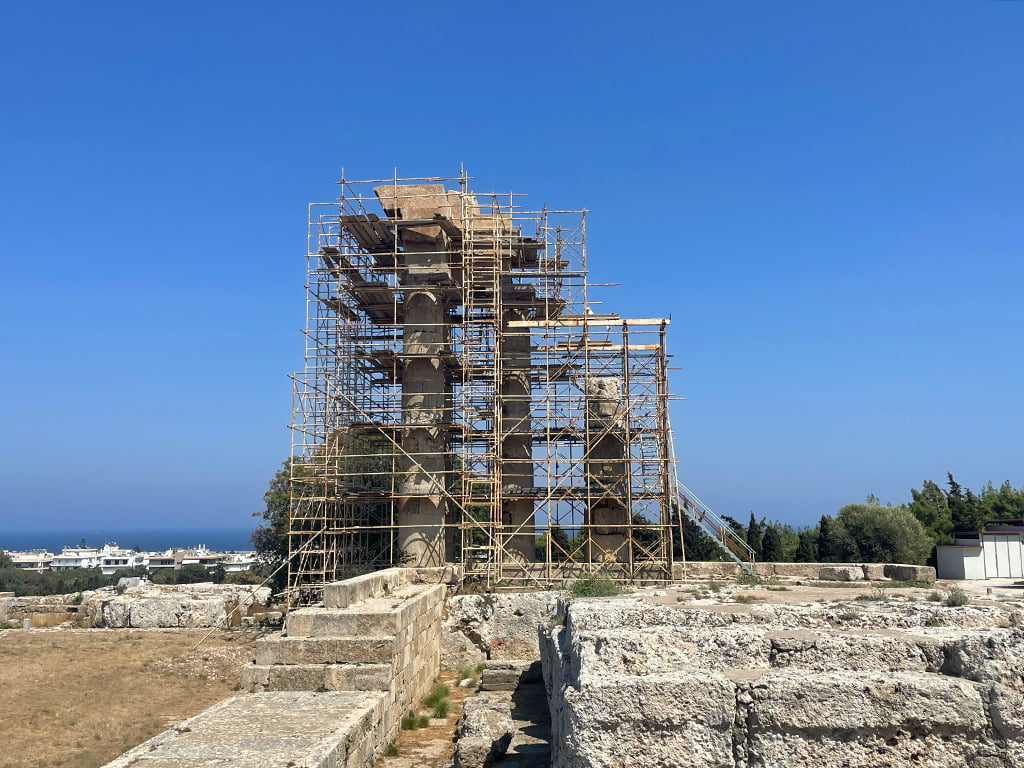
Turning back, we re-enter the old city walls through the Porte d’Ambroise and lose ourselves in the city’s festive streets.
Day 8: Symi
We wake up very early, today we dedicate the day to a boat excursion to Symi, an enchanting island in the Greek Dodecanese.
We take the ferry from Rhodes harbour and in less than two hours arrive at the picturesque port of Symi Town, the island’s main town. Here we are greeted by a unique atmosphere: this picturesque island is famous for its colourful pastel-coloured neoclassical buildings, traditional taverns and craft shops surrounded by crystal-clear blue waters.
The village is actually divided into two large neighbourhoods: Gialos Symi, the lower part near the harbour, and Ano Symi, the higher part of the village. The two neighbourhoods are connected by a large pedestrian street made of stairs, called Kali Strata, which links the harbour part to the upper part of the village. We explore the harbour a little and lose ourselves in the alleys of the centre. We then walk along Kali Strata and climb to the top to enjoy a beautiful view of the bay.

After spending some time in Symi Town, we move on to the bay of Agios Giorgios. This stretch of coastline is known for its natural beauty and crystal-clear water. The taxi boat, stopping at all the beautiful beaches along the coast, passes through breathtaking scenery, olive-covered hillsides and views that leave you breathless. The bay of Agios Giorgios is truly spectacular; thanks to the imposing cliffs behind it, the initial view of the beach takes your breath away. The beach is mainly pebbly with crystal-clear blue waters. It owes its name to the small chapel of Agios Georgios built on the edge of the rock.
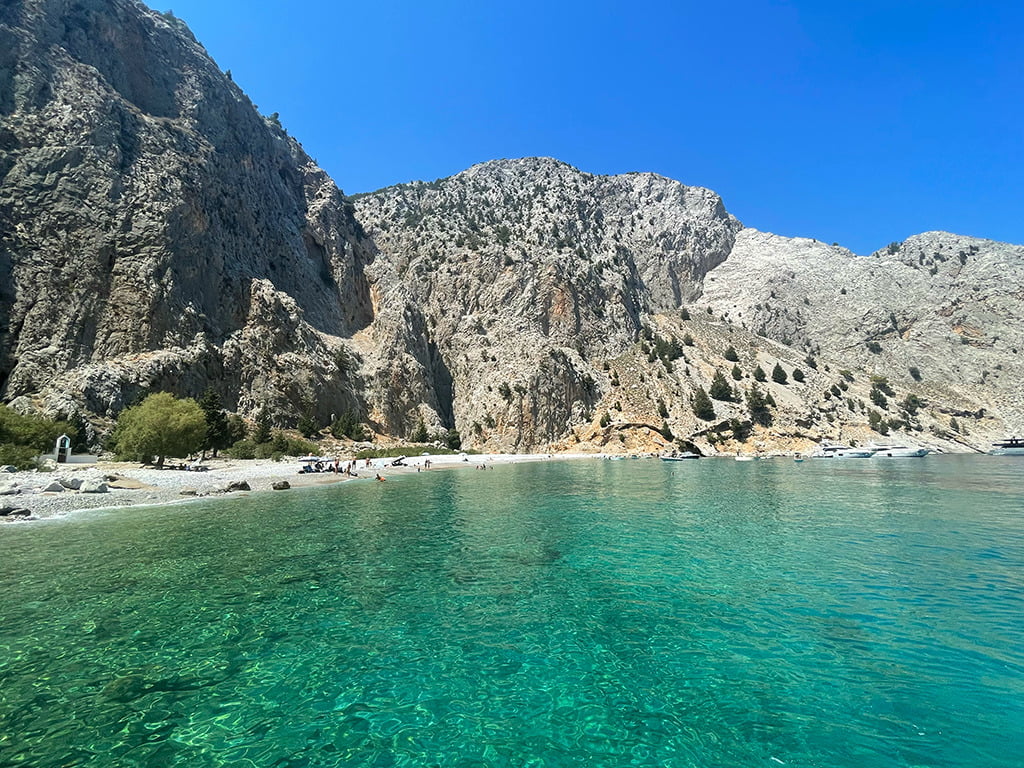
If you enjoyed the first part of this itinerary, continue the journey with us: we move on to Kos.
Last modified: 15 June 2025
